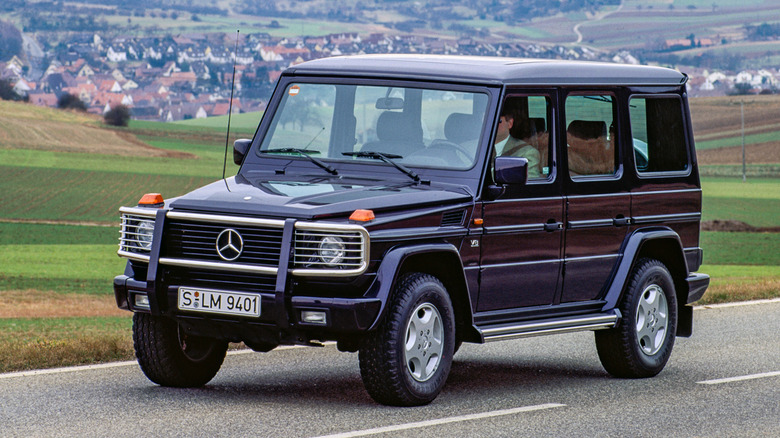Every Iteration Of The Mercedes-Benz G-Class, Ranked Least To Most Valuable
Even though the Mercedes-Benz G-Class appears at first to have hardly changed in its 34 years of production, there have been three generations of the vehicle, and each represented a significant overhaul. It is the second-longest-running Mercedes vehicle still in production, only surpassed by the Unimog.
With every iteration of the G, Mercedes added new technology and engines, completely changed the interior, and made small exterior changes to help keep it looking fresh. If you've just started looking for a used G-Class without much research, you may have been surprised to observe a very broad spectrum of prices for vehicles that don't seem too different. But the vehicle's year, generation, engine, body style, and whether it is a rare or special edition all factor into the asking price.
The fact that the G is considered an iconic off-roader with timeless design helps maintain prices at a certain level, and there is less fluctuation in their used values compared to more mundane vehicles. Many still use these vehicles for their legendary off-road capability, which comes courtesy of the model's roots as a military vehicle.
Let's see how the G-Class generations stack up when ranked by their value and why some are more expensive than others, although you should keep in mind that these are generally regarded as expensive vehicles.
First-generation examples are the least expensive
The most affordable entry point into G-Class ownership is a W460, the first generation, which never officially came to the U.S. It looks most like the original military vehicle that it's based on, and it really reflects the era when it was built (1979–1992), when the notion of a luxury SUV was not as familiar as it is today — the G was seen as a mainly utilitarian proposition in its early years.
You can easily tell you're looking at a first-generation G by its front fenders that taper down, making the vehicle's fascia appear as if it's narrowing. Early Gs also had less prominent fender flares and narrower wheels, and the overall effect was that it made the vehicle appear slender, very different from the look of later models with their wider wheels.
It was available in seven different body configurations, ranging from two-door short-wheelbase variants to five-door long-wheelbase station wagon models. Engines ranged in size from 2 to 3 liters; they had four, five, and six cylinders, and there were both gasoline and diesel units available.
An automatic gearbox was added in 1981, along with air conditioning, and fuel injection came in 1982. The model received other updates in its first years, but they didn't fix its biggest issue — the fact that its engines were underpowered, especially by American standards. This makes W460s some of the least desirable G-Wagens, and this is reflected in their price — if it's not a pristine, original example with hardly any miles, a W460 is the most affordable G that you can find.
According to classic.com, the average price of a W460 G-Class selling on the site was $29,017, calculated from 153 sales.
V8s changed the G-Wagen forever
Mercedes launched the W463 model in 1990 as a major overhaul of the W460. It had a new chassis designation, a revised front-end design, and a generally smoother-looking body. The interior was also completely new and much more upscale, and this newfound style inside was the first stepping stone toward the G-Class becoming the luxury status symbol it is today.
However, just giving it an S-Class-level interior wasn't enough, especially since rival models were combining luxury with big-power engines. The Range Rover showed Mercedes the way forward in this respect, as it had been available with V8 power since the late 1980s, and it was noticeably quicker than any G-Class.
The defining variants for W463 and the G-Class nameplate as a whole are the AMGs. The G-Class got its first V8 in the 1993 500 GE 500 AMG (pictured), which generated 240 horsepower and could hit sixty in 11.4 seconds, but the first AMG-badged G-Class was introduced in 1999. The G55 had a 354-horsepower 5.4-liter V8 engine that, in later model years, was supercharged to make 476 horsepower.
But this mad straight-line performance, combined with the military styling, made the G-Class a staple of all major high streets, and the G55 started it all. It still had three locking differentials and a two-speed transfer case, but this didn't matter for the kind of buyers it was attracting.
W463s are more common than first-generation cars, but because they have better interiors and engines, they fetch a higher price. Classic.com lists the average price of a W463 selling on the site as $101,784 based on 44 sales, although you can find them much cheaper than that if you're not looking for a mint example.
Second-generation W463 deserved its own code name
Even though Mercedes-Benz kept calling the heavily revised G-Class that it launched in 2018 the W463, it brought bigger changes than any previous update, so it would have deserved its own unique chassis designation. If you've ever been in a pre-2018 G-Class, then you know the cabin feels quite narrow, so the fact that the updated version was 4.8 inches wider really made a difference.
It also grew in length, and the overall result was considerably more shoulder and elbow room, as well as additional rear knee room. As with previous iterations, the second-generation W463 received the latest Mercedes interior, complete with Mercedes' dual 12.3-inch screen setup, and between this and the newfound space, it transformed what being aboard a G-Class is like. New turbocharged engines helped boost performance to unseen heights, like in the current Mercedes-AMG G63, which has a 577-horsepower twin-turbo V8, and it reaches sixty in 4.5 seconds.
With the increased track width, the G-Class was also considerably better and more stable to drive on the road, again marking a big departure from any older version. The same model is on sale today, with a starting price of $139,900 without destination charges. The cheapest used 2018 and 2019 model year examples currently have an average asking price of just under $100,000, making this the most expensive G-Class generation.
It's worth noting that some of the most expensive model variants are based on the first W463. In fact, 4x4² models, regardless of which W463 they are based on, will still cost hundreds of thousands even when bought used. For context, the 2023 Mercedes-AMG G63 4x4² has a starting price of $349,000, but with options, it can go north of $400,000.



